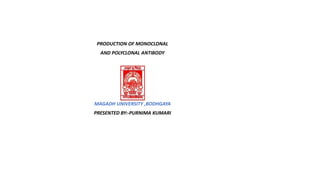
Presentation1 monoclonal and polyclonal antibodies
- 1. PRODUCTION OF MONOCLONAL AND POLYCLONAL ANTIBODY MAGADH UNIVERSITY ,BODHGAYA PRESENTED BY:-PURNIMA KUMARI
- 2. PRODUCTION OF MONOCLONAL ANTIBODY
- 3. ANTIBODY • An antibody is a protein produced by the immune system that is capable of binding with high specificity to an antigen. • These antigens are typically other proteins, but may be carbohydrates, small molecules or even nucleotides. • The specific region on an antigen that an antibody recognizes and binds to is called the epitope, or antigenic determinant. • Serum containing antigen-specific antibodies is called antiserum. There are five classes of immunoglobulins including IgM, IgG, IgA, IgD, and IgE.
- 4. MONOCLONAl ANTIBODY Monoclonal Antibody A monoclonal antibody refers to an antibody normally recognizing only a single antigen (e.g. a single protein) and within which only a single common epitope is recognized. POLYCLONAL ANTIBODY Polyclonal Antibody A polyclonal antibody refers to an antibody normally recognizing only a single antigen but within which a number of different epitopes are recognized.
- 6. PRODUCING MONOCLONAL ANTIBODY • Monoclonal antibodies (mAbs) are produced by immunizing an animal, often a mouse, multiple times with a specific antigen. • B cells from the spleen of the immunized animal are then removed. • Since normal B cells are unable to proliferate forever, they are fused with immortal, cancerous B cells called myeloma cells, toyield hybridoma cells. • All of the cells are then placed in a selective medium that allows only the hybridomas to grow; unfused myeloma cells cannot grow, and any unfused B cells die off. • The hybridomas, which are capable of growing continuously in culture while producing antibodies, are then screened for the desired mAbs. • Those producing the desired mAbs are grown in tissue culture; the culture medium is harvested periodically and mAbs are purified from the medium.
- 7. PRODUCING POLYCLONAL ANTIBODIES • Polyclonal antibodies are often obtained by injecting a lab animal such as a rabbit or a goat with a specific antigen. Within a few weeks, the animal’s immune system will produce high levels of antibodies specific for the antigen. • These antibodies can be harvested in an antiserum, which is whole serum collected from an animal following exposure to an antigen.Because most antigens are complex structures with multiple epitopes, they result in the production of multiple antibodies in the lab animal. • This so- called polyclonal antibody response is also typical of the response to infection by the human immune system. • Antiserum drawn from an animal will thus contain antibodies from multiple clones of B cells, with each B cell responding to a specific epitope on the antigen The process for harvesting polyclonal antibodies produced in response to an antigen.
- 8. • Lab animals are usually injected at least twice with antigen when being used to produce antiserum. • The second injection will activate memory cells that make class IgG antibodies against the antigen. The memory cells also undergo affinity maturation, resulting in a pool of antibodies with higher average affinity. • Affinity maturation occurs because of mutations in the immunoglobulin gene variable regions, resulting in B cells with slightly altered antigen-binding sites. • On re-exposure to the antigen, those B cells capable of producing antibody with higher affinity antigen-binding sites will be stimulated to proliferate and produce more antibody. • Antiserum obtained from animals will not only contain polyclonal antibodies but it will also contain otherantibodies which the animal has been exposed during its lifetime. • For this reason, antisera must first be “purified” to remove other antibodies before using the polyclonal antibodies.
- 9. • Can produce large quantities of identical antibody. Batch to batch homogeneity. • High specificity to a single epitope. Reduced probability of cross reactivity. • Can provide better results in assays requiring quantification of the protein levels. • Significantly more expensive to produce,Require significantly more time to produce and develop thehybridized clone. Small changes in the epitope’s structure often render the monoclonal antibody unable to detect the target protein. • Less ideal for application requiring quick cape of the target protein. More sensitive to pH and buffer conditions. MONOCLONAL ANTIBODIES ADVANTAGES AND DISADVANTAGES
- 10. POLYCLONAL ANTIBODIES ADVANTAGES AND DISADVANTAGES • Inexpensive to produce. Quick to produce. Purified antibody ready to use in under four months. Easy to store. • Highly stable and tolerant of pH or buffer changes. Variability between different batches produced in different animals at different times • Higher potential for cross reactivity due to recognizing multiple epitopes. • Affinity purification of the serum will typically be required to minimize cross reactivity.
- 11. USE OF MONOCLONAL ANTIBODIES • Diagnostic applications :- 1. Detects protein of interest by immune florescence or blotting. 2. Cardiovascular diseases. 3. Deep vein thrombosis. 4. Location of primary and secondary metastatic tumors. 5. Immunosuppressive therapy. 6. Pregnancy testing kits. • Therapeutic applications:- • 1. Radioisotope immune conjugates. • 2. Toxin and drug immune conjugates. • 3. Immunoliposome based kits. • 4. In cancer. 5. Inflammatory disease.
- 12. USES OF POLYCLONAL ANTIBODIES 1. Sandwich ELISA for tumor markers or other antigens can be designed with polyclonal antibodies. 2. To detect a known or unknown is forms of antigens with high antigen homology 3. To detect low levels of a particular antigen 4. To capture as much antigen as possible 5. To detect denatured proteins 6. To detect a target in solutions with varying pH and salt concentrations